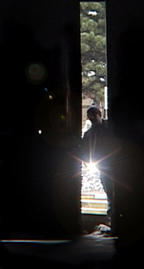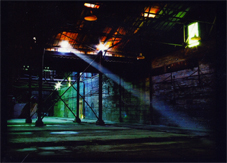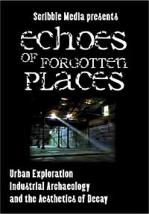|
Get Out And Hug An Abandoned
Factory
I
first became aware of this indie documentary in September 2005, when critic
Dave LeBlanc in Canada’s Globe and Mail newspaper lauded it.
Dave correctly zeroed in on the breathtaking gothic beauty of the crumbling and
abandoned: Wind rustles a ratty curtain hanging on a glassless window. A
gauge, its lens cracked into a brilliant starburst shape, is fixed at 600
kilopascals -- its last measurement. An old desk, drawers open as if gasping
for air, sits crookedly beside its lifelong mate, a limp and dusty chair.
Cool, I thought. And potentially very Ballardian, like a drained swimming
pool with an enigmatic symbol crudely carved in its leafy floor.
 Is the actual documentary as good
as Dave’s florid prose? Yes and No. Yes, insofar as the piece is filled
with enigmatically beautiful shots of the insides of creepily crumbling places,
but No, insofar as Industrial Archaeologist Robert Fantinatto and Urban
Explorer Leesa Beales unfortunately get all sentimental and miss their
opportunity to go beyond the vid's weak premise that these derelicts of the
past should be respected, honoured, even saved for future generations, based
not on their value as examples of architecture, but as mementos to long-dead
workers and the tasks they performed. What? Is the actual documentary as good
as Dave’s florid prose? Yes and No. Yes, insofar as the piece is filled
with enigmatically beautiful shots of the insides of creepily crumbling places,
but No, insofar as Industrial Archaeologist Robert Fantinatto and Urban
Explorer Leesa Beales unfortunately get all sentimental and miss their
opportunity to go beyond the vid's weak premise that these derelicts of the
past should be respected, honoured, even saved for future generations, based
not on their value as examples of architecture, but as mementos to long-dead
workers and the tasks they performed. What?
And that’s too bad,
because this documentary could have been a lot more, well,
psychological, rather than just tree-hugger logical, and the point of
the exercise – to explore some very compelling spaces – would not
have been usurped by Robert and Leesa’s often-cornball script, which
over-romanticizes both the empty buildings and the long-gone workers who once
used the place. They come close to exploring their own psychopathology –
certainly they admit to a desire since childhood to explore abandoned places,
and they do it today to experience a sense of wonder -- but then they lose it
by going all rational and self-conscious, rather than losing themselves in
their imagination and perhaps revealing these spaces as ciphers of alienation,
as landscapes of transition, as metaphors not of death, but of time and
entropy. And having some fun.
Gothic vs Romantic
Sad to say,
this documentary should have followed the Gothic subterranean path, not the
Romantic high road of archaeologists (vs trespassers), explorers (vs
grave-robbers), and official mourners for past Houses of Work, which,
ironically, were no doubt replaced by much more worker-friendly environments.
By the end of the documentary Bob and Leesa and their fellow wanderers come
across as highly ethical, almost scientific explorers, going so far as to risk
their safety in time-pressured attempts to create visual records of these
doomed structures before they are either modified (into malls or condos) or
(gasp) blown up (real good).

Yes, High Standards all round,
yadda yadda, but while you watch the actual montage of interior shots with
Robin Guthrie’s sensitive soundtrack pulsing away (and Leesa, thankfully,
keeping her mouth shut), the true enigmatic power of these eerie spaces is
revealed, and the watcher is rewarded with emotional shudders of forbidden
pleasure, sudden fear, visual wonder, and a sort of creepy feeling at the
alone-ness of these now-alien landscapes. To try and twist this obvious emotive
power into a Remembrance Day for the unlucky proles who once toiled in these
Dickensian monstrosities is, I think, to miss the entire point of sneaking
around these cool places.
 The marketing blurb on Echoes
of Forgotten Spaces says it tries to “bring the past alive,
illuminates the present, and points a cautionary way towards the future.”
In reality, however, the psychopathology of this documentary is revealed in its
graffiti artist roots. Like these nocturnal outsiders who mark spaces with
their personal “tag” to prove they've been there, I suspect this
group of urban explorers basically has fun just getting out and crawling
through abandoned industrial areas, despite their protestations of higher
motivations. For example, the first decaying building we visit is highly tagged
with graffiti, and in the screen credits kudos are given to guys with names
like Blueskunk, Drei, Ferret, Leftist, Panic! and a number of other obvious
graffiti tags. One suspects there's a common bond between the taggers and
industrial archaeologists, as the boys with the spray cans have no doubt
explored (and marked) virtually every abandoned building around here... and any
other city you might be living in. And, just in case you were wondering, the
cameramen in Echoes sneak around decommissioned electric power stations
(coolest), storm drain systems, huge brick factories, assorted abandoned
manufacturing plants, maintenance yards, storage spaces and unidentifiable
rooms with lots of pipes and valves. The marketing blurb on Echoes
of Forgotten Spaces says it tries to “bring the past alive,
illuminates the present, and points a cautionary way towards the future.”
In reality, however, the psychopathology of this documentary is revealed in its
graffiti artist roots. Like these nocturnal outsiders who mark spaces with
their personal “tag” to prove they've been there, I suspect this
group of urban explorers basically has fun just getting out and crawling
through abandoned industrial areas, despite their protestations of higher
motivations. For example, the first decaying building we visit is highly tagged
with graffiti, and in the screen credits kudos are given to guys with names
like Blueskunk, Drei, Ferret, Leftist, Panic! and a number of other obvious
graffiti tags. One suspects there's a common bond between the taggers and
industrial archaeologists, as the boys with the spray cans have no doubt
explored (and marked) virtually every abandoned building around here... and any
other city you might be living in. And, just in case you were wondering, the
cameramen in Echoes sneak around decommissioned electric power stations
(coolest), storm drain systems, huge brick factories, assorted abandoned
manufacturing plants, maintenance yards, storage spaces and unidentifiable
rooms with lots of pipes and valves.
Cocteau Twin Robin
Guthrie's soundtrack -- in actuality cuts from his latest solo album,
Imperial -- senses the "gothness" of the images right away. His
minimalist soundscapes are stunningly appropriate for the images, emotively
leading you through these decrepit canyons of the imagination as the music
meanders through otherwordly landscapes, thowing out sounds which alter and
illuminate the meanings of the pictures. Personally, I’d love to see
a copy of this dvd with no rap, just the images montaged to Guthrie's
soundtrack… now that would be darkly wicked.
Extra Goodies
Not
much. There’s a 1936 US Iron & Steel association flack piece called
Steel: A Symphony Of Industry. Some great shots of stupendous machines
whacking & pouring liquid metal, and a lot of blather about steel mill
safety records – and one great scene in which the announcer brags a worker
is safe from the heat because he’s wearing an asbestos suit! I couldn't
tell if the unlucky guy was coughing. In a way, that anomaly is representative
of the gap between what this documentary shows and what it says. Ironic,
eh?
The other extra on the dvd is a
collection of 125 still photographs, taken by eight photogs from around the
world. The shots are of more urban decay, and they flip automatically,
slideshow-style, but they play with no soundtrack, which is a shame, and just
shows how much Guthrie’s music enhances and explains the images in the
documentary. These shots are great, artistic, but they need music. I’d
recommend anything off
Sunset Mission,
by Bohren und der Club of Gore. Come to think of it, I may watch the entire dvd
with the sound off and Bohren's minimalist doom-jazz creeping thru the
headphones.
Bottom Line: Decay Is
Debest
Do I recommend Echoes? I do
and I don't. I can't figure out Robert & Leesa's sentimentality about these
monuments to old-technology industry, unless they’re looking for a more
socially-acceptable excuse to be creeping around old buildings, or perhaps to
legitimize themselves in an effort to gain entrance to other, more funky,
abandoned spaces in the future. Hey, ya never know. Even worse, you may like
what these cats have to say about preserving the basically useless industrial
past. I say let's toast the old buildings tout de suite and get moving
on abandoning the spaces we're using today. On the other hand, the music is
great and the images are often exquisite -- so it's a trade-off.
You
also don't receive much content for the $18 (Cdn) this thing will set you back,
plus shipping & handling. The 43 minutes of Echoes (and a lot of it
is filler) whips by quickly, and all that's left is a short film... for about
an hour of vid. Still, where else ya gonna go to find other examples of such
large industrial edifices in such a near-death state? Granted, the web has a
huge storehouse of
similar photos of urban dissolution, but tiny files at 72 dpi don't cut it like
colour moving pictures on a widescreen HDTV. If you're tempted to buy, Scribble
Media have a website
with info on how to order a copy of Echoes Of Forgotten Places. Remember
to take a flashlight.
I give it 3 eyes out of 5 because of the boring
political bits.
 

© Rick
McGrath November 2005
Mcourt |

 Is the actual documentary as good
as Dave’s florid prose? Yes and No. Yes, insofar as the piece is filled
with enigmatically beautiful shots of the insides of creepily crumbling places,
but No, insofar as Industrial Archaeologist Robert Fantinatto and Urban
Explorer Leesa Beales unfortunately get all sentimental and miss their
opportunity to go beyond the vid's weak premise that these derelicts of the
past should be respected, honoured, even saved for future generations, based
not on their value as examples of architecture, but as mementos to long-dead
workers and the tasks they performed. What?
Is the actual documentary as good
as Dave’s florid prose? Yes and No. Yes, insofar as the piece is filled
with enigmatically beautiful shots of the insides of creepily crumbling places,
but No, insofar as Industrial Archaeologist Robert Fantinatto and Urban
Explorer Leesa Beales unfortunately get all sentimental and miss their
opportunity to go beyond the vid's weak premise that these derelicts of the
past should be respected, honoured, even saved for future generations, based
not on their value as examples of architecture, but as mementos to long-dead
workers and the tasks they performed. What?
 The marketing blurb on Echoes
of Forgotten Spaces says it tries to “bring the past alive,
illuminates the present, and points a cautionary way towards the future.”
In reality, however, the psychopathology of this documentary is revealed in its
graffiti artist roots. Like these nocturnal outsiders who mark spaces with
their personal “tag” to prove they've been there, I suspect this
group of urban explorers basically has fun just getting out and crawling
through abandoned industrial areas, despite their protestations of higher
motivations. For example, the first decaying building we visit is highly tagged
with graffiti, and in the screen credits kudos are given to guys with names
like Blueskunk, Drei, Ferret, Leftist, Panic! and a number of other obvious
graffiti tags. One suspects there's a common bond between the taggers and
industrial archaeologists, as the boys with the spray cans have no doubt
explored (and marked) virtually every abandoned building around here... and any
other city you might be living in. And, just in case you were wondering, the
cameramen in Echoes sneak around decommissioned electric power stations
(coolest), storm drain systems, huge brick factories, assorted abandoned
manufacturing plants, maintenance yards, storage spaces and unidentifiable
rooms with lots of pipes and valves.
The marketing blurb on Echoes
of Forgotten Spaces says it tries to “bring the past alive,
illuminates the present, and points a cautionary way towards the future.”
In reality, however, the psychopathology of this documentary is revealed in its
graffiti artist roots. Like these nocturnal outsiders who mark spaces with
their personal “tag” to prove they've been there, I suspect this
group of urban explorers basically has fun just getting out and crawling
through abandoned industrial areas, despite their protestations of higher
motivations. For example, the first decaying building we visit is highly tagged
with graffiti, and in the screen credits kudos are given to guys with names
like Blueskunk, Drei, Ferret, Leftist, Panic! and a number of other obvious
graffiti tags. One suspects there's a common bond between the taggers and
industrial archaeologists, as the boys with the spray cans have no doubt
explored (and marked) virtually every abandoned building around here... and any
other city you might be living in. And, just in case you were wondering, the
cameramen in Echoes sneak around decommissioned electric power stations
(coolest), storm drain systems, huge brick factories, assorted abandoned
manufacturing plants, maintenance yards, storage spaces and unidentifiable
rooms with lots of pipes and valves.